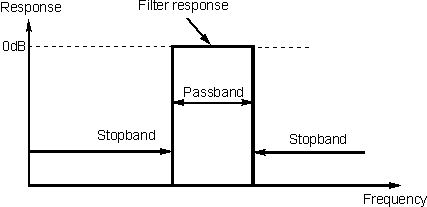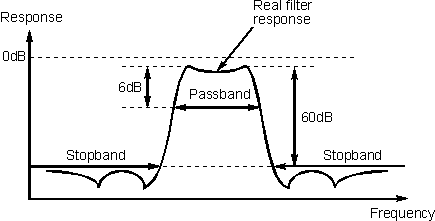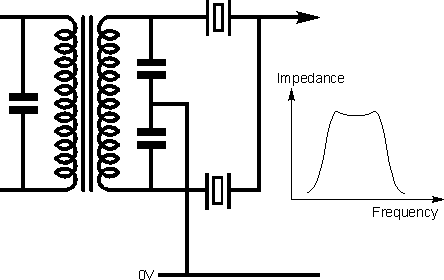Radio receiver selectivity
- overview or tutorial about the basics of radio receiver selectivity
including filter performance and specifications, shape factor, crystal filters,
LC filters, and ceramic filters.
Selectivity is one of the major specifications of any radio
receiver used for any radio communications application whether it is for
broadcast reception, two way radio communications, mobile radio communications,
or any other application. While the sensitivity is important to ensure that it
can pick up the signals and receive them at a sufficient strength, the
selectivity is also very important. It is this parameter that determines whether
the receiver is able to pick out the wanted signal from all the other ones
around it. Many of the filters used in radio receivers have very high levels of
performance and enable radio receivers to select individual signals even in the
presence of many close by other signals.
Superhet principle
Many of the radio receivers used in radio communications
applications today are superhet or superheterodyne radio receivers. In these
radio receivers the incoming signal is converted down to a fixed intermediate
frequency or "IF". It is within the IF stages that the main filters are to be
found. It is the filter in the IF stages that defines the selectivity
performance of the whole radio receiver, and as a result the receiver
selectivity specification is virtually that of the filter itself.

Block diagram of a basic superhet receiver
In some radio receivers simple LC filters may be used,
although ceramic filters are better and are used more widely nowadays. For the
highest performance crystal or mechanical filters may be used, although they are
naturally more costly and this means they are only found in high performance
radio receivers.
Filter parameters
There are two main areas of interest for a filter, the pass
band where it accepts signals and allows them through, and the stop band where
it rejects them. In an ideal world a filter would have a response something like
that shown below. Here it can be seen that there is an immediate transition
between the pass band and the stop band. Also in the pass band the filter does
not introduce any loss and in the stop band no signal is allowed through.

The response of an ideal filter
In reality it is not possible to realise a filter with these
characteristics and a typical response more like that shown below. It is fairly
obvious from the diagram that there are a number of differences. The first is
that there is some loss in the pass band. Secondly the response does not fall
away infinitely fast. Thirdly the stop band attenuation is not infinite, even
though it is very large. Finally it will be noticed that there is some in band
ripple.

Typical response of a real filter
In most filters the attenuation in the pass band is normally
relatively small. For a typical crystal filter figures of 2 - 3 dB are fairly
typical. However it is found that very narrow band filters like those used for
Morse reception may be higher than this. Fortunately it is quite easy to
counteract this loss simply by adding a little extra amplification in the
intermediate frequency stages and this factor is not quoted as part of the
receiver specification.
It can be seen that the filter response does not fall away
infinitely fast, and it is necessary to define the points between which the pass
band lies. For receivers the pass band is taken to be the bandwidth between the
points where the response has fallen by 6 dB, i.e. where it is 6 dB down or -6
dB.
A stop band is also defined. For most radio receiver filters
this is taken to start at the point where the response has fallen by 60 dB,
although the specification for the filter should be checked this as some filters
may not be as good. Sometimes a filter may have the stop band defined for a 50
dB attenuation rather than 60 dB.
Filter shape factor
It can be seen that it is very important for the filter to
achieve its final level of rejection as quickly as possible once outside the
pass band. In other words the response should fall as quickly as possible. To
put a measure on this, a figure known as the shape factor is used. This is
simply a ratio of the bandwidths of the pass band and the stop band. Thus a
filter with a pass band of 3 kHz at -6dB and a figure of 6 kHz at -60 dB for the
stop band would have a shape factor of 2:1. For this figure to have real meaning
the two attenuation figures should also be quoted. As a result the full shape
factor specification should be 2:1 at 6/60 dB.
Filter types
There is a variety of different types of filter that can be
used in a receiver. The older broadcast sets used LC filters. The IF
transformers in the receiver were tuned and it was possible to adjust the
resonant frequency of each transformer using an adjustable ferrite core.
Today ceramic filters are more widely used. Their operation
is based on the piezoelectric effect. The incoming electrical signal is
converted into mechanical vibrations by the piezoelectric effect. These
vibrations are then affected by the mechanical resonances of the ceramic
crystal. As the mechanical vibrations are then linked back to the electric
signal, the overall effect is that the mechanical resonances of the ceramic
crystal affect the electrical signal. The mechanical resonances of the ceramic
exhibit a high level of Q and this is reflected in its performance as an
electrical filter. In this way a high Q filter can be manufactured very easily.
Ceramic filters can be very cheap, some costing only a few
cents. However higher performance ones are also available, and these are likely
to be found in scanners and many other receivers.
For really high levels of filter performance crystal filters
are used. Crystals are made from quartz, a naturally occurring form of silicon,
although today's components are made from synthetically grown quartz. These
crystals also use the piezoelectric effect and operate in the same way as
ceramic filters but they exhibit much higher levels of Q and offer far superior
degrees of selectivity. Being a resonant element they are used in many areas
where an LC resonant element might be found. They are used in oscillators - many
computers have crystal oscillators in them, but they are also widely used in
high performance filters.
Normally crystal filters are made from a number of individual
crystals. The most commonly used configuration is called the half lattice filter
as shown in Figure 4. Further sections can be added to the filter to improve the
performance. Often a filter will be quoted as having a certain number of poles.
There is one pole per crystal, so a six pole crystal filter would contain six
crystals and so forth. Many filters used in amateur communications receivers
will contain either six or eight poles.

A basic half lattice crystal filter section
Choosing the right filter bandwidth
It is important to choose the correct bandwidth for a give
type of signal. It is obviously necessary to ensure that it is not too wide,
otherwise unwanted off-channel signals will be able to pass though the filter.
Conversely if the filter is too narrow then some of the wanted signal will be
rejected and distortion will occur. As different types of transmission occupy
different amounts of spectrum bandwidth it is necessary to tailor the filter
bandwidth to the type of transmission being received. As a result many receivers
switch in different filters for different types of transmission. This may be
done either automatically as part of a mode switch, or using a separate filter
switch. Typically a filter for AM reception on the long and medium wave bands it
is around 9 or 10 kHz and on the short wave bands will have a bandwidth of
around 6 kHz. For SSB reception it will be approximately 2.5 kHz. For Morse
reception 500 and 250 Hz filters are often used.
Summary
Selectivity is a particularly important parameter in any
radio receiver whether it is used for broadcast reception or for use within
another form of radio communications system such as a two way radio
communications link, or a fixed or mobile radio communications application. As a
result it is necessary to ensure that any radio receiver is able to select the
wanted signal as well as it can. Obviously when signals occupy the same
frequency there is little that can be done, but by having a good filter it is
possible to ensure that you have the best chance or receiving and being able to
copy the signal that is required.
|

